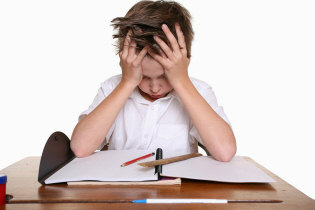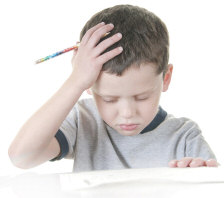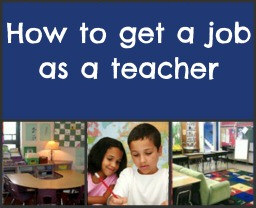Learning Disabilities: Types and Signs
 Introduction: Introduction:
The development of an individual is the result of biological, socio-emotional
and cognitive processes that are intertwined and overlapping. As we grow, we
develop skills related to memory, attention, visuals, auditory, and many more.
Biological processes include appearance, genetic qualities, brain development,
motor skills, perceptual abilities, body functions, and physical attributes like
size and proportions. Socio-emotional processes encompass emotional development,
understanding of oneís self and others, building relationships, reasoning
patterns, behavior and other psychosocial aspects of human life. Cognitive
processes are comprised of skills related to language, memory, attention,
creativity, problem solving, imagination, and acquiring knowledge. Those who
face difficulty in any of these are confronted with troubles as they join the
mainstream schools. This is because all these facilities are equally essential
to excel or even just to survive academically. To cope with school work one must
be able to read, understand what was heard or seen, comprehend vocabulary and
make use of schema to apply them in new situations.
What is a learning disability?
Otherwise known as LD, learning disability or disorder is a general term used
for many kinds of obstacles in learning. Often misinterpreted, learning
disabilities are not connected to having low intelligence or laziness. In fact,
many students who have LD are smart and can compete with others given extra
attention and intervention. They are often judged because of their difficulty to
learn, acquire, access and communicate information. Simply stated, people with
LD differ in their manner of seeing, understanding, and hearing. Their brains
function in a way that they receive, process and communicate information
divergent to what we consider normal. With this, they find it challenging to
learn new skills and to apply them when the need arises.
LDs are products of heterogeneity in peopleís brain processing and that of
their environment. Frequently, teachers and parents tend to assess the child
according to a specific standard like the curriculum, its goals and demands.
This will only increase the challenge for a person with LD as they are deprived
of specialized, structured and individualized activities and measurements to
correct, intervene and develop a specific weakness. When left unnoticed or
neglected, students with LD will likely fall short of achieving academic goals
in math, reading, speaking, writing, listening, and reasoning, resulting to low
achievement and self-confidence.
Learning Disability Types and their Signs
The following are the identified learning disabilities that affect a personís
ability to acquire knowledge and academic skills, thus, impeding success in
social and academic life.
1) Executive
Function LD
Executive function is a cognitive process that
controls all types of brain functions. It sets relationships or associations
between the present and past experiences which is essential to organize things.
When one has executive function LD, planning, organizing, researching,
remembering, managing, and paying attention to even the most basic things is
difficult. With school life being demanding, lacking such skills are obstacles
to leading a team, doing timely and correct projects, answering and listening to
test instructions effectively and even remembering what was read.
2) Dyslexia
 Considered an LD and life-long challenge, this is the inability
to correctly read and spell. Because the brain processes information
differently, it makes recognition and sound production of printed words
troublesome. People with dyslexia find it hard to associate letters to sounds
even at the alphabet level. Because they canít recognize words automatically,
they tend to fall under the label of being slow and inaccurate readers. Since
most coursework are in the written form, dyslexics struggle with acquiring
information from these sources. Consequently, with challenges in decoding
symbols, assigning meaning and comprehension is slow. This LD can extend to
reading, writing and even to speaking. Considered an LD and life-long challenge, this is the inability
to correctly read and spell. Because the brain processes information
differently, it makes recognition and sound production of printed words
troublesome. People with dyslexia find it hard to associate letters to sounds
even at the alphabet level. Because they canít recognize words automatically,
they tend to fall under the label of being slow and inaccurate readers. Since
most coursework are in the written form, dyslexics struggle with acquiring
information from these sources. Consequently, with challenges in decoding
symbols, assigning meaning and comprehension is slow. This LD can extend to
reading, writing and even to speaking.
3) Dyspraxia
A motor skill development, it is the inability to exhibit fine
motor tasks. To some extent, it can even be as displayed by the inefficacy to
brush oneís teeth or even shake hands. Not purely a learning disability, dyspraxia goes along with other LDs that have great impact on learning. A
student with dyspraxia finds it hard to pronounce words correctly as it is
difficult to control muscle movements in speech. Some speak too fast making
their voice incomprehensible. More commonly, it is manifested by the defect in
using scissors, riding bicycles, holding pens, and buttoning shirts. People with
dyspraxia are commonly labeled as being clumsy or uncoordinated.
 4) Dysgraphia 4) Dysgraphia
A motor disability that affects writing, dysgraphia makes it
troublesome for people to put thoughts on paper, spell, and develop good
handwriting. Despite the lines in a notebook, there are visible inconsistencies
as far as the way they write, mostly mixing print with cursive, writing along or
over the lines, slanting directions, omitted letters and uneven spaces between
words on a page. Because they find it hard to imagine the letters, it takes time
to take down notes, and even copying whatís written on the board is tough.
Additionally, they might write letters in reverse or use lowercase and uppercase
inappropriately. They usually do better in speaking than in writing.
5) Dyscalculia
A learning disability with anything that involves math,
because it is difficult to learn arithmetic skills. Students with dyscalculia
find it hard to understand even the simplest concepts in calculating. They find
it challenging to complete activities in lessons like positive and negative
values, addition, multiplication, borrowing, fractions and answering word
problems. There is also an obvious challenge in understanding the concepts of
time, unable to arrange schedules from past to the future, and even managing and
handling money. It can extend to difficulty in making strategies in board games
like chess and even card or online games that require precision.

6) ADHD
Attention Deficit Hyperactivity Disorder (ADHD) is a learning
disability most commonly seen in children. It is exhibited by the lack of
control over oneís behavior and attention. In the classroom, a student with an
ADHD has visible signs of inattentiveness as being easily distracted by external
factors or stimuli. As a result, they usually make mistakes on activities that
demand details, have messy handwriting, and interrupt others. Other than
forgetting daily activities, they tend to have short attention span on tasks,
even while playing, and lose things more often. Because they are unable to
control movement or activity, they are impulsive, acting without thinking,
unable to stay in one place for a while, and are too active.

Final Thoughts
Understanding learning difficulties and their effects on an individual is
necessary to help those with LD. Parents want only the best for their children
and that is natural. Mostly, many would be angry to find out their child has low
grades. Upon finding confirmation of their children having a learning
disability, many would freak out, denying and hiding the truth. This is the
worst thing that can happen as help is needed for the child. It is essential for
parents to know that while academic excellence is important, life does not end
there. Children are given their talents and mostly, this should be discovered
and developed.
When confronted with LD, seek help. Talk to your childís teacher so proper
intervention can be taken. There is a variety of educational programs that cater
to these challenges. Accepting the situation and supporting your child can open
doors to finding the perfect assistance needed to augment LD. Instead of pushing
your child too much and demanding grades far beyond what is reasonable, show
support first. Find ways to make the child live a fulfilling and meaningful life
by giving encouragement. Remember that above everyone else, they expect you to
be the source of strength and inspiration to build lifeís foundation with a
strong and confident mindset. After all, having LD is not a definite obstacle to
success.
Learning
How to Overcome Test Anxiety
15 Incredible Yet Weird Story Lessons About Wisdom
Myths and Realities on Bilingualism
The Benefits of Being Bilingual
Learning Disabilities: Types and Signs
The Role of Listening in Language Learning
Helping Your Child Develop a Love for Writing
How to Teach Your Kids to Read
The Influence of Music on Childrenís Learning
Teachers
5 Reasons to Use Norm Referenced Tests in the Classroom
5 Ways to Use Criterion Referenced Test in the Classroom
Photo Memoir: Writing Assignment
Top 5 Things to Know About Your ESL Studentsí Backgrounds
Group Work in College ESL Classrooms
How to Teach Business English in ESL Setting
Benefits of Using Graphic Organizers in the Classroom
How to Use Storytelling in Language Teaching
How to Correct Student Essays
The Most Common Problems in ESL Classrooms
Tips on Teaching ESL Students Vocabulary
Praise: A Great Motivator for Student Achievement
Peer Feedback is a Great Tool in Writing Classes
 |